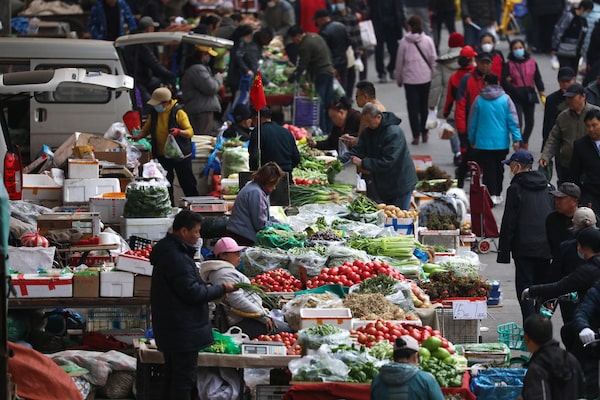
People buy vegetables at a market in Shenyang, in northeastern China's Liaoning province, on April 11.STR/Getty Images
China’s consumer inflation cooled more than expected in March, while producer price deflation persisted, maintaining pressure on policy-makers to launch more stimulus as demand remains weak.
Worrying deflationary pressures in the world’s second-largest economy appear to be slowly easing, though a protracted property crisis is still weighing heavily on consumer and business confidence.
Consumer prices rose by a muted 0.1 per cent in March from a year earlier, National Bureau of Statistics (NBS) data showed on Thursday, versus a 0.7 per cent rise in February which was the first gain in six months and a 0.4 per cent rise in a Reuters poll.
Data over the January-February period and factory surveys for March showing improving demand had been a relief for Chinese officials seeking to spur a feeble post-COVID recovery, but economists warned of Lunar New Year distortions.
“Seasonal effects definitely played a role – food prices rose sharply during the Chinese New Year in February and subsequently came back down,” said Xu Tianchen, senior economist at the Economist Intelligence Unit.
“More broadly, the overcapacity issue is passing into prices in a way that will thwart the People’s Bank of China’s efforts to reflate the economy,” Xu added. “Vehicle prices fell an annual 4.6 per cent, which could suggest manufacturers are introducing deeper price cuts in the distribution and sales process.”
Producer prices in March fell 2.8 per cent year on year, widening a 2.7 per cent slide the previous month and extending a year-and-a-half long stretch of declines. On a month-on-month basis, PPI fell 0.1 per cent.
“Although consumer prices are no longer falling, rapid investment in manufacturing capacity is still weighing on factory-gate prices,” said Julian Evans-Pritchard, head of China economics at Capital Economics.
In recent months China has rolled out a raft of incentives to spur household spending including easier car loan rules, but consumers remain cautious about big-ticket purchases amid worries about the sputtering economy and the weak job market.
Annual core inflation, excluding volatile food and energy prices, was at 0.6 per cent in March, slower than 1.2 per cent in February. The CPI fell 1.0 per cent month-on-month, cooling from a 1 per cent gain in February and worse than a 0.5 per cent drop forecast by economists.
The People’s Bank of China (PBOC) pledged earlier this month to support the growth of household incomes and meet reasonable credit demand from consumers while curbing “blind expansion” in industries with overcapacity.
Some analysts believe the central bank faces a challenge as more credit is flowing to production than into consumption, exposing structural flaws in the economy and reducing the effectiveness of its monetary policy tools.
“While we believe that data will gradually show that China is not stuck in a deflationary spiral, nonetheless inflation remains well below target, and looking at economic fundamentals alone, we think the economy would benefit from further rate cuts,” said Lynn Song, chief economist for Greater China at ING.
Prolonged weakness in demand is also raising questions about the government’s difficulties in finding new economic growth models.
Foreign direct investment flows are slowing, according to balance of payment data, as foreign firms repatriate earnings to benefit from higher interest rates in the U.S. while the PBOC keeps rates low to encourage lending.
“Interestingly, CPI inflation surprised on the upside in the U.S. and downside in China,” said Zhiwei Zhang, chief economist at Pinpoint Asset Management.
“This indicates the monetary policy stances in these two countries may continue to diverge as well, hence the gap of interest rates in these two countries will likely persist.”
On Wednesday, credit rating Fitch cut its outlook on China’s sovereign credit rates to negative, citing risks to public finances as growth slows and debt continues to rise.